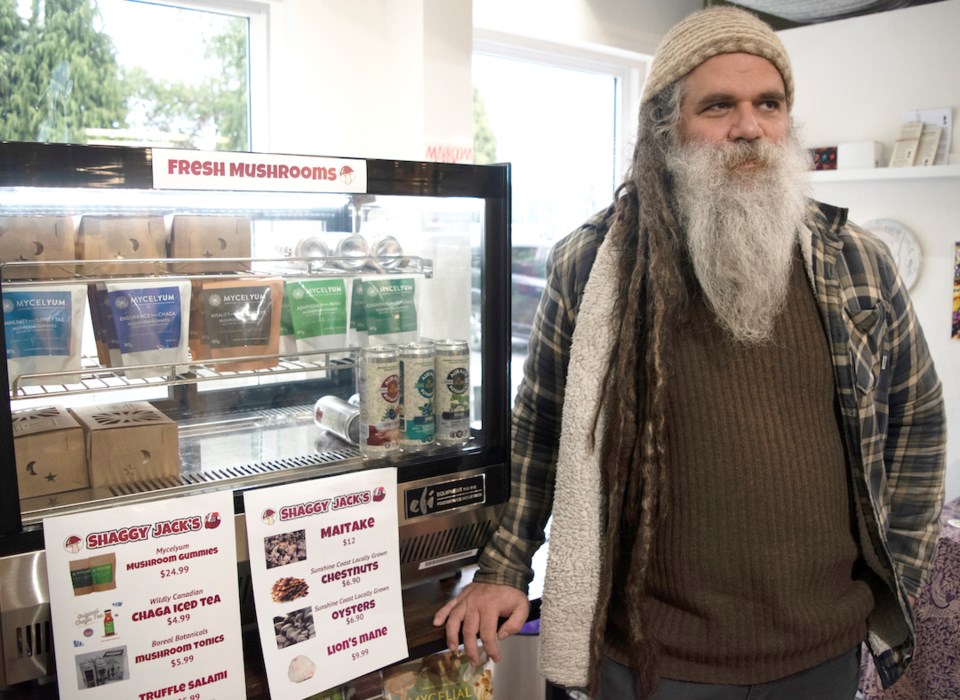In an unfortunate ironic twist, a week before the Sunshine Coast’s annual mushroom festival was set to start, the fridge at organizer Jody “Shaggy Jack” Franklin’s retail location in Gibsons was missing a key ingredient – wild foraged mushrooms.
Mid-October is typically peak season for mushroom foraging in B.C., with heavy autumn rains arousing abundant blooms of chanterelles and the prized matsutake, or pine mushroom, from the forest floor.
But this year’s drought has caused a dearth in the dirt.
Worst season in recent years
Franklin, who has foraged commercially for 20 years, said it’s the worst season he’s seen on the Coast since arriving in 2012.
“In previous years in farmer’s markets, we’ve got fresh, wild local mushrooms on the table every week. That didn’t happen at all this summer,” he told Coast Reporter Oct. 21. The scarcity has continued into the fall because of persistent dry, summerlike weather.
Jeremy Budd, co-owner of West Coast Wild Foods said this has been the worst season since 2009, when he launched his business. The company has buyers in communities across B.C., including in Roberts Creek.
“There’s essentially no mushrooms where the drought has been,” he said. “Sunshine Coast, Vancouver Island, everywhere south of Bella Coola there was essentially no crop of wild mushrooms.”
This high-pressure ridge that built over B.C. meant there was no moisture, there was no fall temperatures… so no mushrooms grew.”
Lost revenues, high prices
No mushrooms is bad for business. Franklin said he’s lost at least $10,000 or more of anticipated revenue. “It’s impacted our business plan and some of the things we were hoping to do.” he said.
The business, which he founded with Andrea Coates, has expanded into other areas to mitigate the risks of variable mushroom seasons.
“I’m more concerned about the commercial foragers who are either full-time or supplement their incomes this time of year,” said Franklin.
Fall is normally West Coast Wild Foods' busiest time of year. The Burnaby-based company supplies wild mushrooms to restaurants, retailers, and small distributors in the Lower Mainland and every major city in Canada and the U.S. “This year it just hasn’t been there at all,” said Budd.
Seasonal staff needed to grade chanterelles haven’t been hired this year. Hours have been cut.
The scarcity has also led to historically high prices for chantarelles in B.C. – about double the typical price of $3 to $5 per lb. And there’s a limit to how much restaurants and other buyers are willing to spend on the product, so “there’s no real benefit” to the increase in value, said Budd.
Even foragers don’t see gains from the higher prices because the mushrooms are so scarce.
The size of the commercial market for edible wild mushrooms in B.C. isn’t clear.
A technical report by the Government of BC from 2003 identifies matsutake and Pacific golden chanterelles as dominant species, due in part to the difficulty involved in cultivating them domestically.
Another provincial publication estimates between 2,000 and 5,000 people harvest pine mushrooms in the province. While another puts the value of wild edible mushrooms exported to Europe and Japan from B.C. at $14 million.
Drought's effects on mycelial health 'not clear'
One silver lining is that a lack of mushrooms in the forest isn’t necessarily a health indicator of the parent mycelium underground.
University of B.C. Botany professor Mary Berbee, who worked on the development of a mushroom identification app for foragers, said there’s a “tremendous lack of data” on mushroom diversity and ecology in the province, including on the correlation between mushroom fruiting and drought.
Because of that lack of research, however, the silver lining is also a black hole.
“That’s part of the problem – we don’t really know how stressed the underlying entire mushroom individual is, actually, at this point in time.”
Berbee said it’s “absolutely not clear” what effect seasonal drought could have on mycelial health. While Pacific coastal mushrooms are likely adapted to a low rain season as part of their evolutionary history, “this [drought] is different, it’s really dry. And I am completely unclear on what that means,” she said.
The Vancouver Mycological Society is also expecting “a really sparse year,” she said. This is the season of mushroom shows. “All the organizers are concerned about whether or not there’s going to be anything besides a few woody conks and some lichen.”
As for the Sunshine Coast MushrooMania festival, it’s moving ahead.
While the fridge at Franklin’s retail location is devoid of anything wild, it’s still stocked with locally cultivated varieties – and with rain on the way, both he and Budd are hopeful for a late bloom.
Budd, who started harvesting mushrooms in Roberts Creek at the age of seven, said fall has always been his favourite time of year because of trips into the woods harvesting with his father. “I’ve seen crops come in mid-November, going back to the early 1990s. I think there’s a chance with the chanterelles.”



